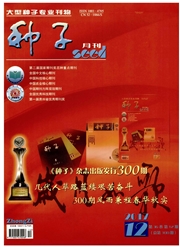

 中文摘要:
中文摘要:
大豆种子的耐储藏性是评价大豆种子质量的重要指标。大豆种子的耐储藏性通常可通过测定自然老化种子的活力来确定。自然老化历时较长,而人工老化则可弥补其所需时间较长的不足,但对两者间的一致性尚有争议。本实验对21份大豆种质的人工老化和自然老化进行了比较,结果表明,大豆种质经人工老化处理后,16份种质的发芽率等活力指标低于自然老化处理,2份种质的发芽率等活力指标与自然老化处理无差异,3份种质的的发芽率等活力指标高于自然老化处理。相关分析表明,两者呈显著正相关。对于大部分的种质来讲,人工老化能较好地反映自然老化的过程,但仍有少量种质的人工老化和自然老化结果间差异较大。另外,人工老化处理种质的发芽率等活力指标与粗脂肪含量呈正相关,与籽粒大小和粗蛋白含量呈负相关。
 英文摘要:
英文摘要:
Seed longevity is an important index for assessing the soybean seed quality and it can be assessed by germination rate of naturally aged soybean seed. While the naturally aging usually takes a long time, artificially aging can save much time. There are, however, some inconsistencies between these two kinds of treatments. In this study,the seed vigor of 21 soybean germplasms were tested with germination characteristics after being artificially aged and naturally aged respectively. The results showed that 16 germplasms possessed the lower germination characteristics after being artificially aged compared with being naturally aged. while 2 artificially aged germplasms possessed the same and 3 artificially aged germplasms possessed higher germination charac- teristics compared with those being naturally aged. Association analysis identified that the germination charac- teristics of being artificially aged were positive related with those of being naturally aged, which indicating that the artificially aging was a good alternative way to assess the seed longevity compared with naturally aging for most of germplasms. Additionally, the germination characteristics of artificially aged germplasms was positively related with rule oil content, and negatively related with seed size and rule protein content. The results in this paper would set a solid foundation for further researches on the soybean seed longevity.
 同期刊论文项目
同期刊论文项目
 同项目期刊论文
同项目期刊论文
 期刊信息
期刊信息
